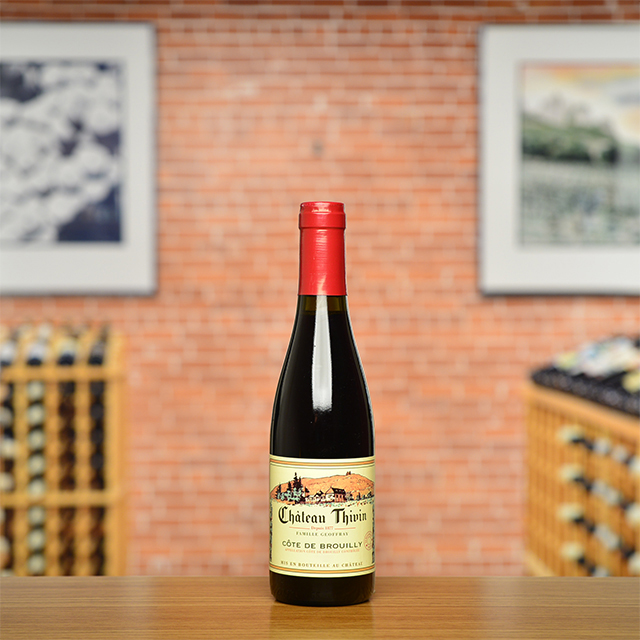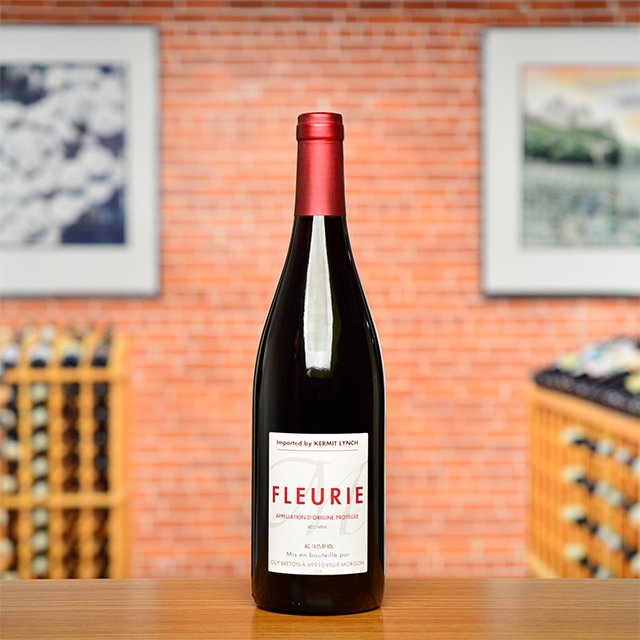Notify me
2020 Côte de Brouilly
Château Thivin
Fritz Rench, a special person in my family, just celebrated his ninetieth birthday. His enthusiasm for Château Thivin may be unmatched in this world. To put things in perspective, I’m almost half his age, and he’s been drinking (and visiting) Thivin since before I was born. In any wine shop where his travels take him, his first question is, without fail, “Got any Château Thivin?” He knows that there is Beaujolais, there is Côte de Brouilly . . . and then there is Château Thivin. The superb 2020 vintage may be the best Thivin ever. It’s got it all, and so much more. Fritz, here’s to you! I have a case of the 2020 here in the cellar with your name on it, ready for your next visit.
—Chris Santini
| Wine Type: | red |
| Vintage: | 2020 |
| Bottle Size: | 750mL |
| Blend: | Gamay |
| Appellation: | Côte de Brouilly |
| Country: | France |
| Region: | Beaujolais |
| Producer: | Château Thivin |
| Winemaker: | Claude Geoffray |
| Vineyard: | Average of 50 years, 8.3 ha |
| Soil: | Blue volcanic rock comprised of plagioclase and biotite |
| Aging: | Ages in oak foudres for six months before bottling |
| Farming: | Organic (certified) |
| Alcohol: | 14.1% |
More from this Producer or Region

2024 Côte de Brouilly HALF BOTTLE
France | Beaujolais
Loaded with wild fruit, spice, and crunchy minerality, Thivin's Côte de Brouilly marries to perfection with soulful cuisine.

2024 Fleurie
France | Beaujolais
Guy Breton’s Fleurie is delicate, with buffed tannins and juicy fruit; it will leave your thirst slaked and your heart feeling light.

2024 Brouilly “Reverdon”
France | Beaujolais
This bottling is classic Brouilly, balanced and old-school, and showcases the beauty of Gamay.

2023 Moulin-à-Vent “Sous la Roche”
France | Beaujolais
It combines the structural grandeur typical of Moulin-à-Vent with a high-elevation freshness.

2021 Brouilly
France | Beaujolais
A generous dash of plump, sun-ripened fruit enveloping a granite core.

2024 Côte de Brouilly MAGNUM
France | Beaujolais
Château Thivin’s Côte de Brouilly seamlessly fuses pleasure, class, and intellect.

2023 Beaujolais Blanc “Clos de Rochebonne”
France | Beaujolais
Rochebonne offers Chardonnay fruit that’s both racy and sun-kissed

2023 Côte de Brouilly
France | Beaujolais
Alex Foillard fashions a Côte-de-Brouilly that strikes a deeper register, saturating the senses with tooth-staining fruit, gritty earth, and just a touch of the good funk.

2024 Côte de Brouilly
France | Beaujolais
Brambly and mineral, this bottling exudes both the convivial charm of Gamay and the crunchy intensity of the Côte de Brouilly.

2018 Brouilly
France | Beaujolais
A generous dash of plump, sun-ripened fruit enveloping a granite core
About The Producer
Château Thivin
It is no surprise that Château Thivin is the benchmark domaine of the Côte de Brouilly; everything about it is exceptional. Built in the fifteenth century on an ancient volcano which juts out steeply into the valley below, Thivin is the oldest estate on Mont Brouilly, In 1976, Richard Olney took Kermit to visit on their first wine trip together. It was Olney’s top recommendation in the whole of the Beaujolais region. The current generation of the Geoffray family continues their tradition. Today their grandnephew Claude, his wife Evelyne, and their son Claude-Edouard continue the tradition as staunch and proud defenders of the terroir of the Côte de Brouilly.
About The Region
Beaujolais

After years of the region’s reputation being co-opted by mass-produced Beaujolais Nouveau and the prevalence of industrial farming, the fortunes of vignerons from the Beaujolais have been on the rise in the past couple of decades. Much of this change is due to Jules Chauvet, a prominent Beaujolais producer who Kermit worked with in the 1980s and arguably the father of the natural wine movement, who advocated not using herbicides or pesticides in vineyards, not chaptalizing, fermenting with ambient yeasts, and vinifying without SO2. Chief among Chauvet’s followers was Marcel Lapierre and his three friends, Jean Foillard, Guy Breton, and Jean-Paul Thévenet—a group of Morgon producers who Kermit dubbed “the Gang of Four.” The espousal of Chauvet’s methods led to a dramatic change in quality of wines from Beaujolais and with that an increased interest and appreciation for the AOC crus, Villages, and regular Beaujolais bottlings.
The crus of Beaujolais are interpreted through the Gamay grape and each illuminate the variety of great terroirs available in the region. Distinguishing itself from the clay and limestone of Burgundy, Beaujolais soils are predominantly decomposed granite, with pockets of blue volcanic rock. The primary vinification method is carbonic maceration, where grapes are not crushed, but instead whole clusters are placed in a tank, thus allowing fermentation to take place inside each grape berry.
Much like the easy-going and friendly nature of many Beaujolais vignerons, the wines too have a lively and easy-drinking spirit. They are versatile at table but make particularly good matches with the local pork sausages and charcuterie. Though often considered a wine that must be drunk young, many of the top crus offer great aging potential.
More from Beaujolais or France
2023 Chénas “Vibrations”
Domaine Thillardon France | Beaujolais
2023 Côte de Brouilly
Alex Foillard France | Beaujolais
2024 Beaujolais MAGNUM
Domaine Dupeuble France | Beaujolais
2023 Chénas “Chassignol”
Domaine Thillardon France | Beaujolais
2024 Beaujolais
Domaine Dupeuble France | Beaujolais
2024 Morgon “Vieilles Vignes”
Guy Breton France | Beaujolais
2024 Brouilly “Reverdon”
Château Thivin France | Beaujolais
2024 Côte de Brouilly HALF BOTTLE
Château Thivin France | Beaujolais
2023 Morgon “Vieilles Vignes”
Guy Breton France | Beaujolais
2024 Morgon “La Roche Pilée”
Jean-Paul et Charly Thévenet France | Beaujolais
2024 Beaujolais-Villages
Alex Foillard France | Beaujolais
2024 Morgon
M. & C. Lapierre France | Beaujolais
2023 Chénas “Vibrations”
Domaine Thillardon France | Beaujolais
2023 Côte de Brouilly
Alex Foillard France | Beaujolais
2024 Beaujolais MAGNUM
Domaine Dupeuble France | Beaujolais
2023 Chénas “Chassignol”
Domaine Thillardon France | Beaujolais
2024 Beaujolais
Domaine Dupeuble France | Beaujolais
2024 Morgon “Vieilles Vignes”
Guy Breton France | Beaujolais
2024 Brouilly “Reverdon”
Château Thivin France | Beaujolais
2024 Côte de Brouilly HALF BOTTLE
Château Thivin France | Beaujolais
2023 Morgon “Vieilles Vignes”
Guy Breton France | Beaujolais
2024 Morgon “La Roche Pilée”
Jean-Paul et Charly Thévenet France | Beaujolais
2024 Beaujolais-Villages
Alex Foillard France | Beaujolais
2024 Morgon
M. & C. Lapierre France | Beaujolais
Kermit once said...

Kermit once said...
Living wines have ups and downs just as people do, periods of glory and dog days, too. If wine did not remind me of real life, I would not care about it so much.



















